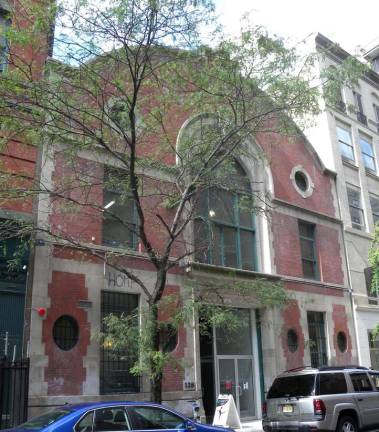Former Frank Stella Studio Saved in East Village

Preservationists, residents, politicians save 128 E. 13th St. following six-year push It took six years to accomplish, but hard work and perseverance paid off for city preservationists as the city's Landmarks Preservation Commission (LPC) voted unanimously last week to landmark 128 E. 13th St., a building once used to auction off horses. The campaign to landmark the 1903 building, whose varied uses included the city's last surviving horse auction mart, studio space for famed painter and sculptor Frank Stella and a World War II-era defense industry training center for women, was spearheaded by the Greenwich Village Society for Historic Preservation (GVSHP) and had support from Council Member Rosie Mendez and the Historic Districts Council, among others. "This designation was especially gratifying, in part because it was so long in the making and in part because we came so close to losing the building," said Andrew Berman, GVSHP executive director. In 2006, Berman's group uncovered a plan by a new owner to tear the building down and replace it with a seven-story condo. Berman said that shortly after that discovery, his organization alerted the LPC and requested an emergency hearing to save the building. The hearing was made possible because the new owner had not yet filed demolition permits, creating a small window of opportunity to try to save the building. "128 East 13th Street's progression from a place where horses, then manufactured goods and then great works of art were produced perfectly captures the arc of downtown's development," Berman said during his 2006 testimony before the LPC. While the building's use from 1978 to 2005 as the studio of renowned artist Stella was well known, research supplied to the landmark's commission from the GVSHP revealed it was originally built as the Van Tassel and Kearney Horse Auction mart, a place where affluent city families, including the Vanderbilts, Delanos and Belmonts, went to inspect and select horses for purchase. Distinguishing physical traits of the building include high central halls, where horses were paraded around on rings for potential buyers to review. The GVSHP's research also showed that although horse auction marts were at one time very common buildings in New York City, this was the last remaining intact structure of its type. Despite the fact that the LPC's emergency hearing in 2006 prevented demolition of the building, the commission refrained from voting on designation for six years. In 2007, the building was listed on the State and National Registers of Historic Places and in 2008 the GVSHP sent a letter signed by Borough President Scott Stringer, State Sen. Tom Duane, Mendez and Assembly Member Deborah Glick in a renewed attempt to push for landmark designation. "This is a good example of how a historic building can be adapted to new uses that benefit its community without sacrificing its historic character," said Simeon Bankoff, executive director of the Historic Districts Council, referring to the building's current tenant, the Peridance Capezio Dance Center. "After six years of pushing for landmark status, the Village and the city can now be assured that this unique monument, which evolved from a place which produced horses to manufactured goods to great works of art, will be with us for generations to come," Berman said in an emailed statement. "And with it," he continued, "a steel and masonry record of New York and the Village's dramatic evolution over the 20th century will also be preserved."